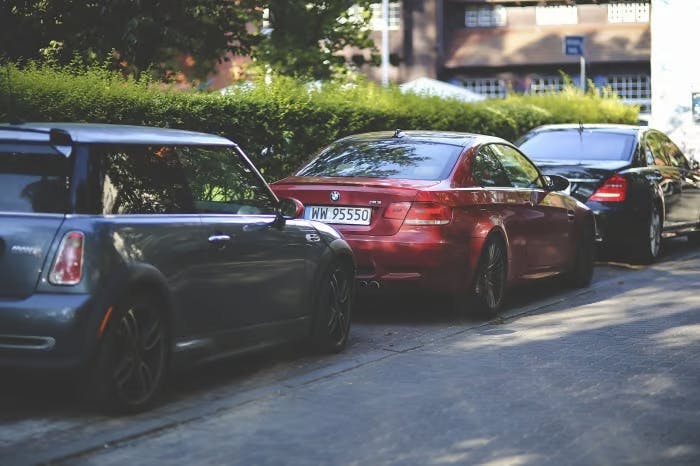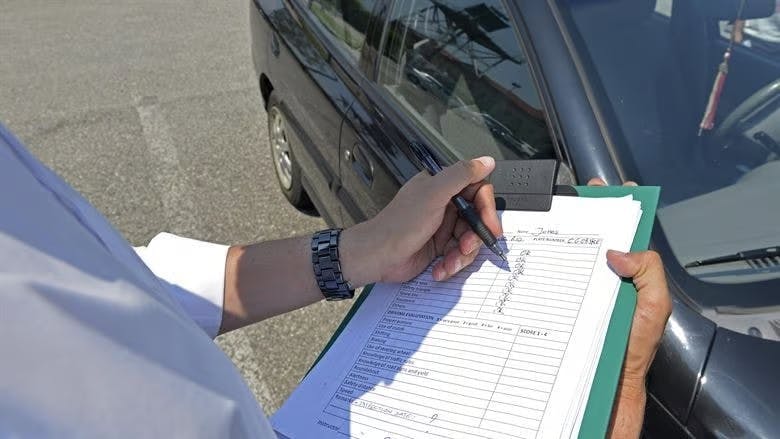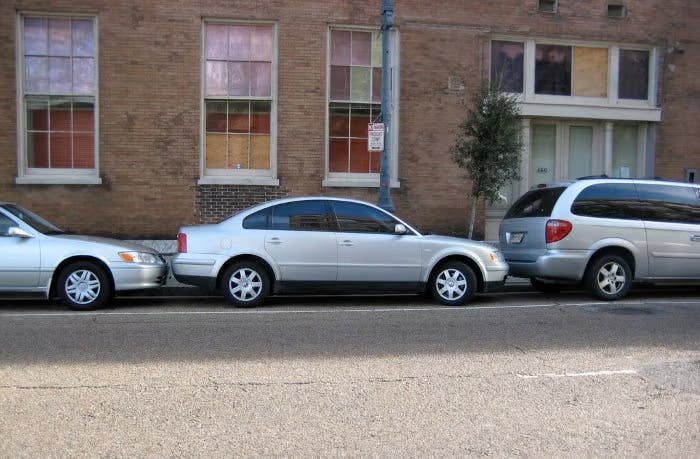
Learner drivers certainly have their work cut out for them when it comes to preparing for the practical test. From getting to grips with clutch control to mastering the art of safely navigating around parked cars whilst meeting oncoming traffic, your newfound skills will be well and truly tested. Of course, one of the biggest areas of interest (and/or fear) for learners is manoeuvres. Parallel parking is one of three manoeuvres that you could be asked to demonstrate during your test. Not mastered it yet? PassMeFast's guide to parallel parking will have you up to speed in no time!
In this guide, we're going to completely break down the parallel parking manoeuvre—looking at how to demonstrate it safely, what the examiner will be looking for and when it might be used in real-life conditions.
What is parallel parking?
One of three manoeuvres in the driving test, the parallel parking manoeuvre is pretty simple. The clue is in the name—it will involve you parking your vehicle parallel to the road, typically in a line of other vehicles. During your practical test, you'll usually have to drive your vehicle next to the vehicle in front of the space you want to park in, before you reverse in. Though parallel parking is one of the most disliked manoeuvres for learners, it's easy enough to get your head around with enough practice.
There's a 1-in-3 chance that you'll be asked to complete the parallel parking manoeuvre during your test. If you are asked to demonstrate it, the instructions from the examiner will sound something like this:
“Stop on the left well before you get to the next parked car, please. This is the parallel parking exercise. When you're ready, drive forward and stop alongside the car ahead. Then, reverse into the space behind the other vehicle, and park reasonably close to and parallel with the kerb. Try to complete the exercise within two car lengths.”
What is the examiner looking for?

As the candidate works their way through the parallel parking manoeuvre, the examiner will be keeping a close eye on their control of the vehicle. This will include how well they handle the clutch and the accuracy to which they park next to the kerb. Throughout the manoeuvre, they will be monitoring how often the learner checks their mirrors and blindspots, and how aware they are of their surroundings. The examiner will also be watching how steady the candidate is with their steering, both during their point of turn and as they straighten up their vehicle.
As you progress through the parallel parking manoeuvre, the examiner will be looking out for:
- Coordination. Not only do you need to reverse and steer with a high level of accuracy, you also have to use your MSM routines to make sure you're aware of any changes in your surroundings.
- Precision. With parallel parking, if you're off by just a little, it could have disastrous consequences. As such, you need to ensure your steering is precise, and that you get the vehicle within a reasonable distance of the kerb—without hitting it or ending up too far away.
- Control. Speed can make or break a manoeuvre. The examiner doesn't expect you to finish the manoeuvre in 30 seconds. If you keep things slow, you'll stay in complete control of your vehicle.
Please note:
- When you're demonstrating the parallel parking manoeuvre, you may become a hazard to other drivers. As such, it's absolutely vital that you maintain a constant level of observation and make sure it's safe to go ahead.
- Whilst the examiner will usually pick the spot for you to parallel park into, outside of the test, it will be your responsibility to make sure you pick a space that your car will definitely fit into. If you're not too sure, pick out another spot—it's better to be safe than sorry, after all!
Step-by-step: How do I parallel park?
1. Pull alongside the car
The examiner will begin by asking you to park on the left-hand side of the road, well before the nearest parked vehicle. Once you've done so, they'll relay the rest of the instructions and watch as you drive forward next to the other car in preparation for your parallel park.
- Before you even begin moving back out, you need to check your right-hand mirror and blindspot—even if it's only moments after you've stopped, you never know what might have changed on the road.
- If there's a lot of oncoming traffic, you'll want to wait until it's clear. Otherwise, you'll be holding up traffic while you try to demonstrate the manoeuvre. Trust us—you don't want that added pressure!
- Once it's clear, start to move the car slowly by making careful use of your clutch. As you pull alongside the other car, check your mirrors once again for oncoming vehicles, cyclists or pedestrians. If anyone is approaching, simply use your left indicators to tell them what you're doing.
- Try to stop your car a little bit ahead of the other vehicle. Make sure you're leaving enough space between you—if you're too close, you run the risk of colliding with the other car. You're looking at a distance of around half a metre to a metre.
- Once you've stopped, cancel your indicator and select the reverse gear—the reverse lights will let other road users know what your intentions are.

2. MSM and correct positioning
Now that you've positioned your car just after the other vehicle, it's almost time for you to begin the reversing part of the manoeuvre. Before you can even think about it, though, you need to take a few important precautions.
- As with any manoeuvre, frequent all-round observations are absolutely vital. Make use of all of your mirrors and check your blindspots! If you see any oncoming vehicles, cyclists or pedestrians, stop what you're doing and let them pass. It will make things easier on you if you do.
- Once you're sure it's clear, you're almost good to go (remember to keep checking your side mirrors). First things first, you need to keep your eyes peeled on your rear window, as this is the direction you'll be moving in.
- Keeping things slow is how you'll nail this manoeuvre—so keep it at a snail's pace and show off some of that good clutch control! Remember, if you're going slow enough, you'll be able to make necessary adjustments as you go along.
- Now it's time to get the rears of both vehicles level. During your lessons, your instructor will have likely given you example reference points to follow, e.g., if the vehicles are the same size, you should line up the side mirrors. As a rule of thumb, it's always better to move your car a bit further back than too forward—you'll end up colliding with the other vehicle otherwise.
- As you level your vehicle, remember to keep checking your mirrors and blindspots for other road users. Once you're happy with your positioning, it's time for you to stop the car.

3. Find your reference point and reverse into the spot
Your car is now in the perfect position for you to reverse into your chosen spot. Don't forget your MSM routine as you move—this is one of the most potentially hazardous parts of the parallel park manoeuvre.
- The point of turn is the moment in which you simultaneously reverse and steer—the front of your vehicle will swing out towards the road. As you can imagine, this can be pretty dangerous if there happens to be oncoming road users. As such, give your mirrors and blindspots another check.
- Once it's clear, you can begin slowly reversing—keeping an eye out of the rear window. As you do, steer the wheel around once to the left. A shallow turn makes you far less likely to turn into the other vehicle.
- As you approach your next reference point—the point at which you start to straighten up the vehicle—you need to keep checking for road users. If there's oncoming traffic, stop what you're doing and let them pass. The same will apply if you see pedestrians.
- Typically speaking, your reference point is usually when the left corner of your vehicle lines up with the right corner of the other vehicle. (Not sure if the same applies to your vehicle? Before the test, ask your instructor.)
- If you want to break the manoeuvre up—making it easier for you to spot when you might need to make adjustments—you can opt to stop here once you've reached your reference.

4. Full lock and straighten up
You're now almost at the end of the parallel park manoeuvre. Don't get too cocky though—you've still got to straighten up and make sure you don't hit the kerb (and get an instant driving test fault).
- Once you've got your reference lined up, it's time to steer full right lock—getting your car parallel with the kerb. As you do, remember, all-round checks are still vital. Examiners will be watching to see how aware you are of your surroundings, so keep glancing at your interior and exterior mirrors.
- Slow and steady does it as you reverse your vehicle. You need to keep an eye on your left-hand mirror to make sure that your car is both parallel to the kerb and a suitable distance away from it.
- Think you're off? Contrary to popular driving test myths, you don't need to complete the manoeuvre in one smooth motion—you're allowed to make adjustments. If you're off, simply switch to first gear and move back to your point of turn. Before you do so, you need to make sure you check it's clear.
- If your car is in a suitable position, it's time to straighten yourself up. Before you stop completely, steer one left turn to straighten up your wheels. Then, apply your handbrake and select neutral.
- If you've left a gap of more than 2 car lengths between your vehicle and the one in front, select first gear and move forward to get a bit closer. Not too close though—you'll still need to move off after once the examiner gives you the go-ahead.
And there you have it! You've now mastered the art of the parallel park. As with every other manoeuvre, we always advise learners break the parallel park down into smaller, more manageable stages. After all, it doesn't seem half as intimidating when you're able to work through each step one at a time.

When would this be used in real life?

Let's face it, you'd be pretty hard pressed to find a driver who hasn't ever had to parallel park, or been in a situation in which being able to so would have been beneficial. If you live in any sort of residential area, especially ones where space is limited, you'll need to be able to parallel park. After all, unless your neighbours don't have cars, it's unlikely that you'll always have the option to drive forward into a parking space.
Even if parking isn't an issue at home, you've still got to deal with things like inner city parking. If you can't find a car park, or all of your available options are full, parallel parking on a street might be the only way you'll get a spot in a place where space is sparse. Please note: if you've managed to pick out a good parking space (that you'll definitely be able to fit into!) make sure there aren't any parking restrictions in place—you don't want to pick up a parking ticket!
FAQs
1. What are the chances I'll be asked to complete this manoeuvre?
You have a 1-in-3 chance of being asked to demonstrate the parallel parking manoeuvre on your practical test. Don't be tempted to forgo practising parallel parking in the hopes that you'll be asked to complete another manoeuvre—make sure you know all three manoeuvres like the back of your hand.
2. What other manoeuvres are there?
Other than parallel parking, there are two additional manoeuvres that you might be asked to demonstrate during your practical test. These manoeuvres are:
- Pulling up on the right
- Bay parking—either reversing into a parking space and driving out, or driving into a parking space and reversing out.
3. Can I refuse to complete the parallel park?
To put it simply, if you want your driving test to continue—and you want to get your hands on that full driving licence—there's no way that you can refuse to complete the parallel park if you're asked to do so by the examiner. If you're confused about something, you are allowed to ask questions. The examiner will be more than happy to explain their instructions. Outright refusal of a manoeuvre, however, will simply end in a terminated test.
4. Where will I be asked to carry out this manoeuvre?
It's entirely up to the examiner to pick the location of where you'll have to demonstrate a parallel park. Despite what you might think, examiners aren't limited to quiet, residential areas when it comes to manoeuvres—they're allowed to test your skills on busier roads too. That being said, with it being a parallel park, it's likely that they'll pick a relatively quiet area. They won't want to run the risk of you holding up traffic on a busy street.
5. When in the test will I be asked to demonstrate this manoeuvre?
As with the location of the manoeuvre, it's entirely up to the examiner to decide when they want to you to carry out the manoeuvre—the DVSA doesn't give them a designated time or anything. As there's no real way of knowing, there's absolutely no point in you panicking about it. Simply concentrate on your driving and tackle the parallel park if and when you're asked to.
6. What should I do if I think I'm about to hit the kerb?
It's important to remember, as with any manoeuvre, that you are allowed to take your time. Instead of rushing through the parallel park, take a breath and slow things down. If you're using your mirrors correctly, you'll be able to tell straight away if you're too close to the kerb. If this happens, make the necessary adjustments—drive forward to your point of turn and try again.
7. Will the examiner get out to check how far I am from the kerb?
Odds are that your driving examiner will have assessed hundreds of learner drivers by this point. As such, it's highly unlikely that they'll need to get out to check—they'll just know right off the bat. Remember, they're using your mirrors as well.
8. Will I automatically fail if I hit the kerb?
It depends on how badly you hit the kerb. If it's the slightest nudge, the examiner might not notice or might just allow you to continue anyway—it's up to their discretion after all. If you end up mounting the kerb, however, then yes, you're looking at an automatic fail. As we've said, if you take your time and use your mirrors, you should be able to stop before this happens.
9. How long is two car lengths?
The examiner will ask you to park within two car lengths of the vehicle in front. Now, standard parking spaces are 15.7ft (4.8m), which makes two car lengths around 31.4ft (9.6m). You should be able to make an educated guess as to how far back you need to reverse—it doesn't need to be exact.
10. What if there's a lot of oncoming traffic when I'm trying to complete this manoeuvre?
If you've waited a long while, and there's still a lot of oncoming traffic, you are allowed to go ahead (unless the examiner specifies otherwise). Simply indicate to let other road users know what your intentions are, and if they wait, start your parallel park. Though you might feel pressured into rushing your manoeuvre, take your time.
11. Is there a time limit in place for completing this manoeuvre?
Not really. The examiner isn't going to sit there with a timer once they've asked you to carry out the parallel park. As a rough guess, we'd say you probably have around 4 minutes or so. Again, it's not like the examiner is going to time you—though if you're dragging it out or having to adjust several times, they will start to hurry you along.
12. Will I fail if I can't complete the manoeuvre?
Whilst manoeuvres are intimidating for most learners, it's important that you don't let this overwhelm you on the day. You are allowed to make small mistakes on your test—no-one is perfect, after all. That being said, if you hit the kerb or outright refuse to finish the parallel park, then yes, you're going to fail your test.
13. Do I have to complete the parallel park in one move?
Contrary to popular belief, you don't have to complete the parallel park in one move. Let's face it, even veteran drivers sometimes need to take things in stages. In fact, we urge learners to break their manoeuvres down into steps and minimise the risk of making silly mistakes.
14. Will the examiner check how far I am from the car in front?
As with your distance from the kerb, it is highly unlikely that the examiner is going to get out and measure how far you are from the car in front. They'll be able to tell straight off the bat if you're too far away—in which case, they might give you a slight nudge and ask you to move further back.
Subscribe for driving advice, offers & more
We'd love to let you know about our courses, news and offers via email. You may unsubscribe at any time.
Star Genie Limited trading as PassMeFast. Company number 10093359
Copyright © 2024 owned by Star Genie Limited
PassMeFast, Blue Tower, MediaCityUK, Salford, M50 2ST

